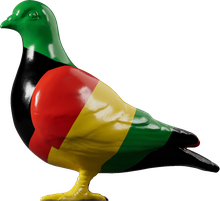Decorative arts — C. 1753-1756
Plaque
This enamel plaque features a transfer-printed image of Hibernia receiving an apple from Paris before Britannia. In Greek mythology Paris gave an apple to the goddess Aphrodite, who he chose over Hera and Athena owing to her beauty. The allusion may be to Elizabeth and Maria Gunning, sisters from an impoverished Anglo-Irish gentry family, who married into the British aristocracy. The Gunning sisters arrived in London in 1751 and gained a reputation for their beauty in high society. Elizabeth married the Duke of Hamilton, and Maria married the Earl of Coventry. It is likely that Hibernia on the plaque represents Maria Gunning. The image was designed by the Irish artist James Gwin and engraved by the Frenchman Simon François Ravenet.
The Battersea Enamel Factory was founded in 1753 by the merchant-politician Stephen Theodore Janssen. One of his partners was the Irish engraver John Brooks, who claimed to have invented transfer printing. Brooks unsuccessfully attempted to patent the technique in 1751. Brooks and Janssen were both declared bankrupt in 1756 and the factory closed.
- Category:
- Decorative arts
- Object ID:
- A13145
- Object name:
- plaque
- Object type:
- Artist/Maker:
- Battersea Enamel Factory, Ravenet, Simon François
- Related people:
- Related events:
- Related places:
York House, Battersea, Wandsworth, London [Wandsworth], Wandsworth
- Production date:
- c. 1753-1756
- Material:
enamel, metal
- Measurements/duration:
- H 124 mm, W 79 mm, D 8 mm (overall)
- Part of:
- —
- On display:
- —
- Record quality:
- 100%
- Part of this object:
- —
- Owner Status & Credit:
Permanent collection
- Copyright holder:
digital image © London Museum
- Image credit:
- —
- Creative commons usage:
- —
- License this image:
To license this image for commercial use, please contact the London Museum Picture Library.

